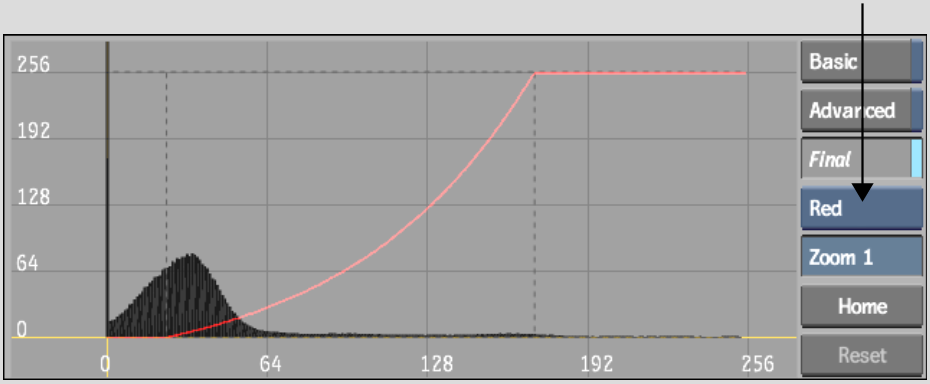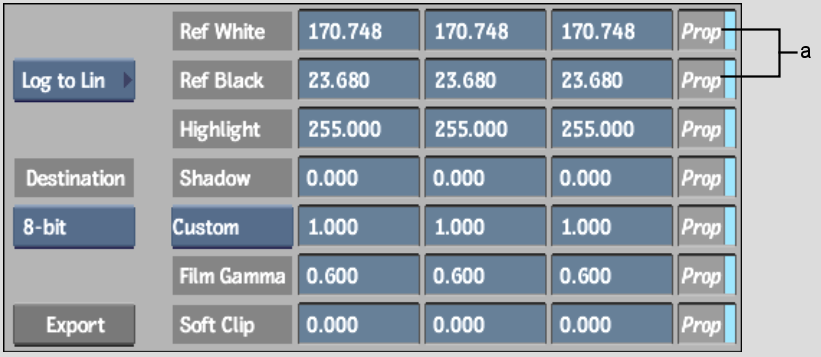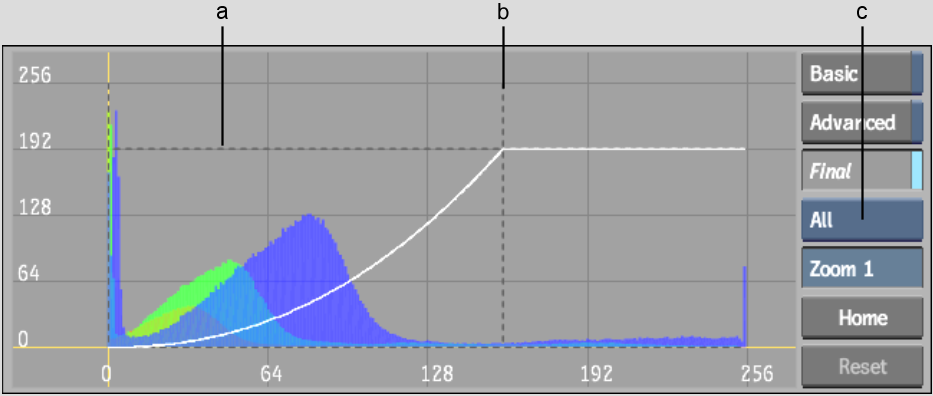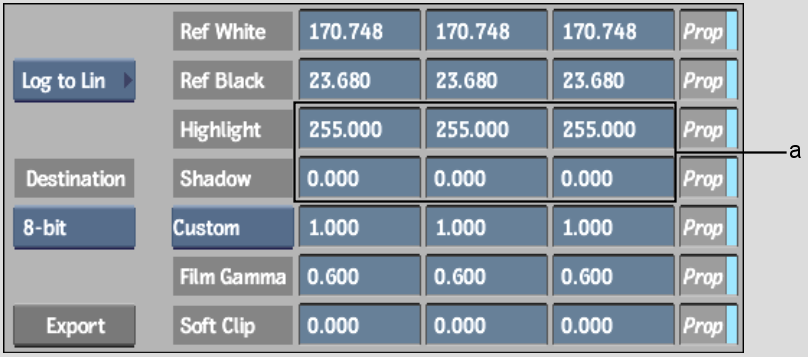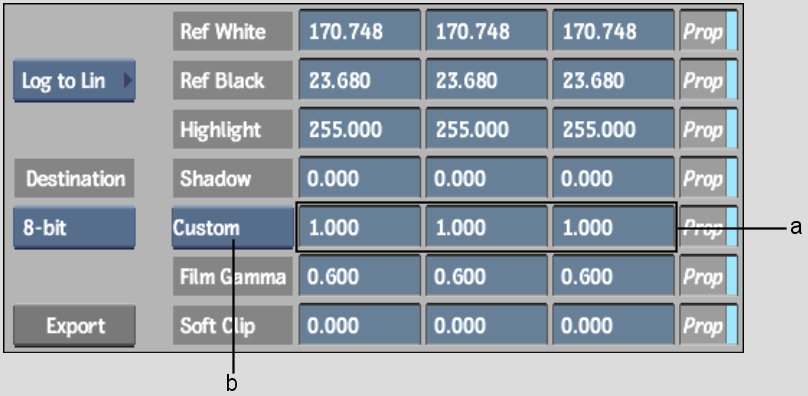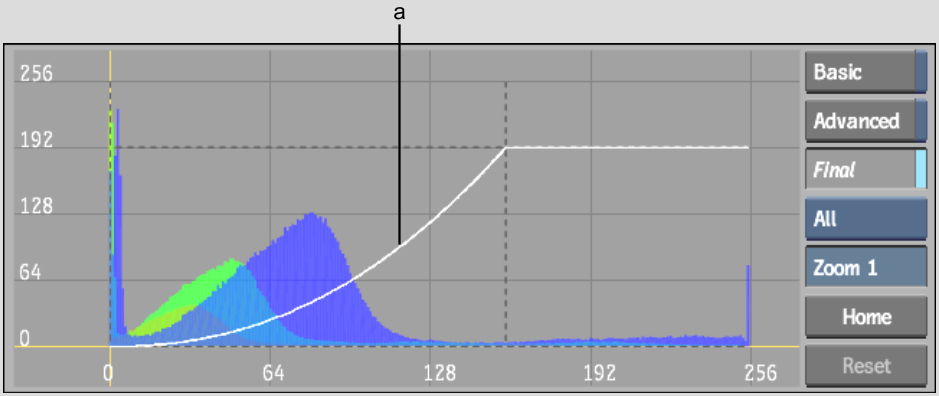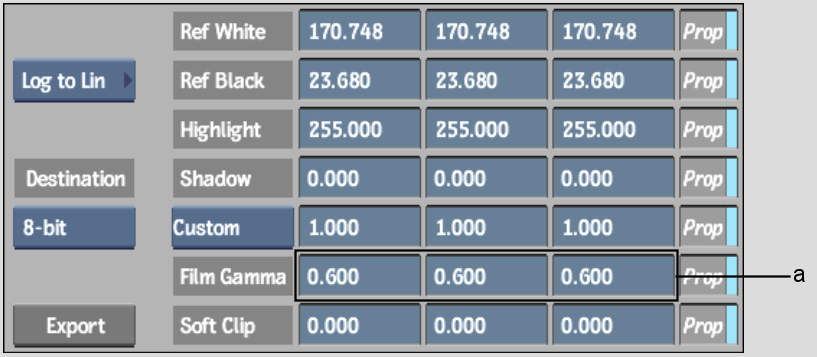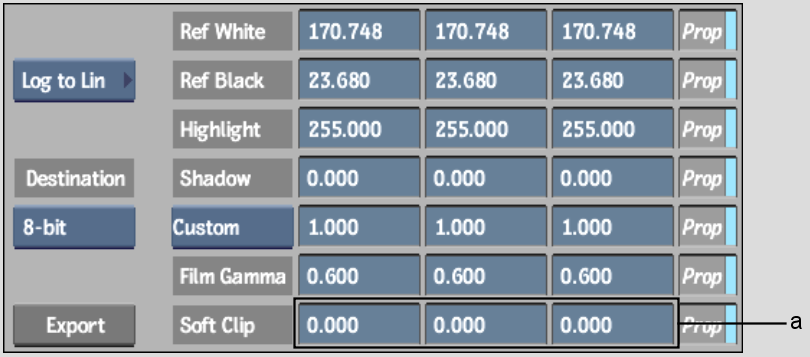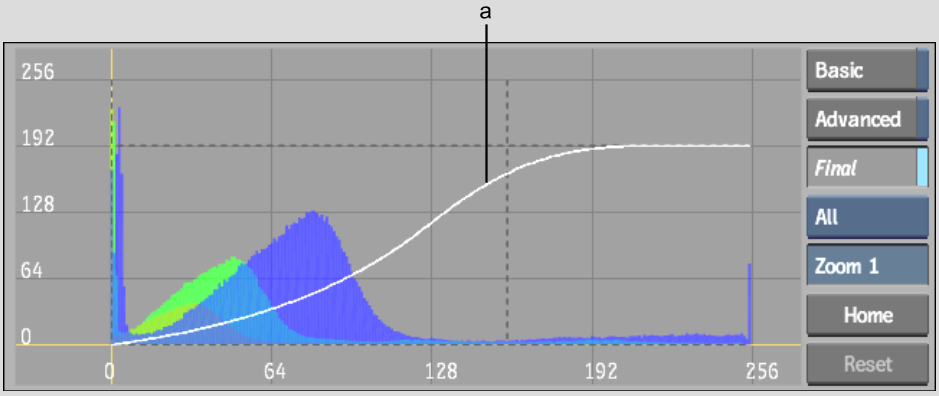Show in Contents

Add to Favorites

Home: Flint

Defining a Basic LUT Type

Creating Custom 1D LUTs

Advanced Editing of the Conversion LUT Curve

Modifying Basic Conversion LUT Curves
Once you define a basic LUT type, you can modify:
- The
reference white and reference black values
- The
highlights and shadows
- The
gamma of the conversion curve
- The
gamma of the incoming film negative
- The
degree to which the shoulder at the upper end of the conversion
curve is softened
When you modify these values, the basic LUT
curves are updated to reflect the changes. For all procedures, you
can monitor the R, G, and B channels independently while modifying
the LUT.
NoteThe procedures in this section apply to
predefined LUTs and LUTs that have been loaded. They do not apply to LUTs that have been
imported.
To
monitor the R, G, and B channels independently:
- From
the Edit Curve box, select Red, Green, or Blue to monitor the red, green,
or blue channels independently.
Modifying Reference White and Reference Black
Values
The
reference white and reference black values define the intensity
levels at which incoming pixels are considered white or black respectively.
For example, selecting a logarithmic-to-linear basic conversion
LUT curve sets the reference white to 685 and the reference black
to 95. (These have been shown to be good values for Kodak™ film stock.) As a result,
source pixels with values from 685 and 1023 will produce white pixels,
while those from 0 and 95 will bet set to black.
Reference white and black are affected by the
values assigned to highlights and shadows. White pixels are mapped
to the value set for highlights, while black pixels are mapped to
the value set for shadows. See
Modifying Highlights and Shadows.
To
modify reference white or black values using the Ref White and Ref
Black fields:
- Do
one of the following:
- To
set proportional R, G, and B values, enable Prop and then enter
the value in one of the (left-to-right) R, G, and B Ref White and
Ref Black fields.
- To
set independent R, G, or B values, disable Prop and then enter the
value in the corresponding (left-to-right) R, G, or B Ref White
and Ref Black fields.
To
modify reference white or black values using the LUT Editor graph:
- Do
one of the following:
- To
set proportional R, G, and B values, select All from the Edit Curve
box, and then drag the vertical reference white or reference black
line left or right.
- To
set independent R, G, or B values, select Red, Green, or Blue from
the Edit Curve box, and then drag the vertical reference white or
reference black line left or right.
TipIf you already entered independent values
and want to modify the R, G, and B values proportionally, you must
drag the reference white or reference black line that corresponds
to the corresponding channel. To view the selected R, G, or B luma
values as a greyscale luma image in the Import Image menu, enable
the Exclusive button.
Modifying Highlights and Shadows
Highlight and shadow values define the maximum
and minimum values permitted for each channel. All values above
the highlight are clamped down to it. Similarly, all values below
the shadow are clamped up.
To
modify highlight and shadow values using the Highlights and Shadows fields:
- Do
one of the following:
- To
set proportional R, G, and B values, enable Prop and enter a value
in one of the (left-to-right) R, G, and B Highlights and Shadows
fields.
- To
set independent R, G, or B values, disable Prop and enter the value
in the corresponding (left-to-right) R, G, or B Highlights and Shadows
fields.
To
modify highlight or shadow values using the LUT Editor graph:
- Do
one of the following:
- To
set proportional R, G, and B values, select All from the Edit Curve
box, and then drag the horizontal highlight or shadow line up or
down.
- To
set independent R, G, or B values, select Red, Green, or Blue from
the Edit Curve box, and then drag the horizontal highlight or shadow
line up or down.
Modifying the Gamma of the Conversion Curve
Set
the gamma correction value to correspond to the display gamma you
set your system to use. You can select a preset from the Gamma Correction
box or enter a custom value.
To
modify the gamma correction curve using the Gamma Correction fields:
- Select
an option from the Gamma Correction box.
| Select: |
To: |
| Video Display |
Set video gamma correction presets. |
| Custom |
Enter custom gamma values. |
- If
you selected Custom, do one of the following:
- To
set proportional custom R, G, and B gamma correction values, enable Prop,
and then enter the value in one of the (left-to-right) R, G, and
B Gamma Correction fields.
- To
set independent custom R, G, or B gamma correction values, disable Prop,
and then enter the value in the corresponding (left-to-right) R,
G, or B Gamma Correction field.
To
modify the gamma correction curve using the LUT Editor graph:
- Do
one of the following:
- To
modify the combined R, G, and B gamma correction curves proportionally,
select All from the Edit Curve box, and then drag the gamma correction
curve left or right.
- To
set independent R, G, or B values, select Red, Green, or Blue from
the Edit Curve box, and then drag the gamma correction curve left
or right.
Modifying the Gamma of the Incoming Film Negative
The values in the Film Gamma fields
affect the gamma correction curve inversely to the Gamma Correction
fields. This is because the gamma correction performed using these
controls is based on the gamma of the original film negative. Typically,
the gamma of a film negative is 0.6. Only adjust this value if your
film negative is of a non-standard gamma. You should not have to
modify this value by very much.
NoteFilm
Gamma fields are not available if you are using the LUT Editor node in
Batch because in the middle of a process pipeline you typically
input a source that has already been gamma corrected for your display
environment. In this case, you generally use the LUT Editor to apply
a static colour correction.
To
modify the gamma correction curve using the Film Gamma fields:
- Do
one of the following:
- To
set proportional custom R, G, and B gamma correction values, enable Prop
and then enter the value in one of the (left-to-right) R, G, and
B Film Gamma fields.
- To
set independent custom R, G, or B gamma correction values, disable Prop
and then enter the value in the corresponding (left-to-right) R,
G, or B Film Gamma field.
Adjusting the Softclip Values
You can soften the shoulder
of the gamma correction curve by adjusting the Softclip values.
When you soften the shoulder of the conversion curve, you soften
the transition of colours toward the reference white value. This
results in less harsh highlights in your clip.
To
soften the shoulder of the gamma correction curve using the Softclip fields:
- Do
one of the following:
- To
set proportional custom R, G, and B gamma correction values, enable Prop,
and then enter the value in one of the (left-to-right) R, G, and
B Softclip fields.
- To
set independent custom R, G, or B gamma correction values, disable Prop,
and then enter the value in the corresponding (left-to-right) R,
G, or B Softclip field.
To
soften the shoulder of the gamma correction curve using the LUT
Editor graph:
- Do
one of the following:
- To
soften the shoulder of the combined R, G, and B gamma correction curves
proportionally, select All from the Edit Curve box, and then Shift-drag the gamma correction
curve left or right.
- To
soften the shoulder of the R, G, or B curves separately, select
Red, Green, or Blue from the Edit Curve box, and then Shift-drag the gamma correction
curve left or right.


